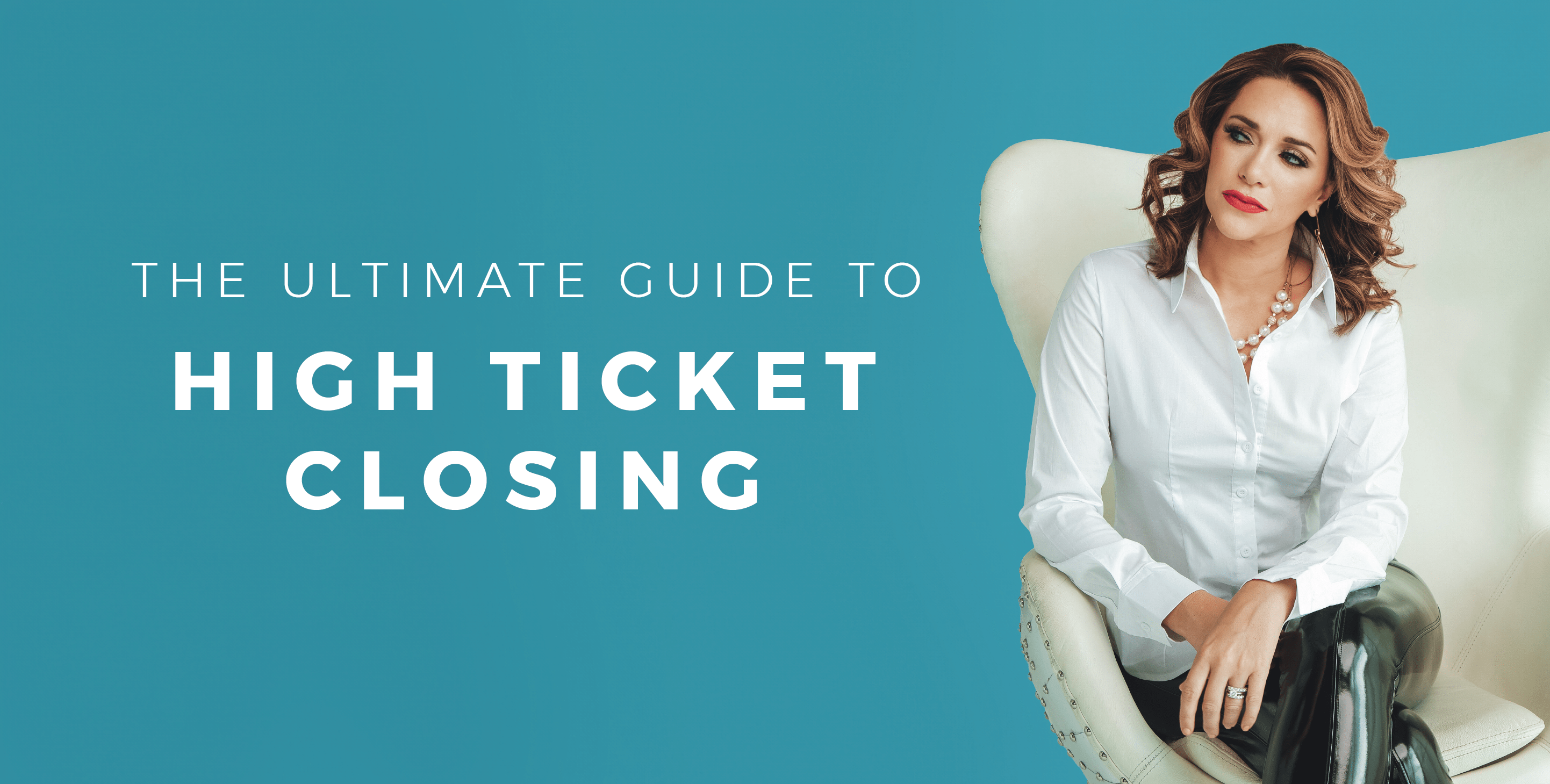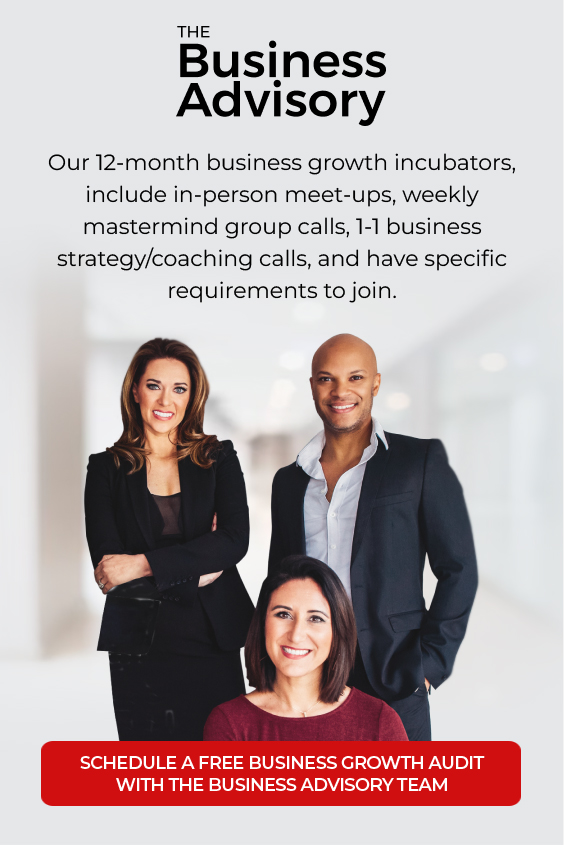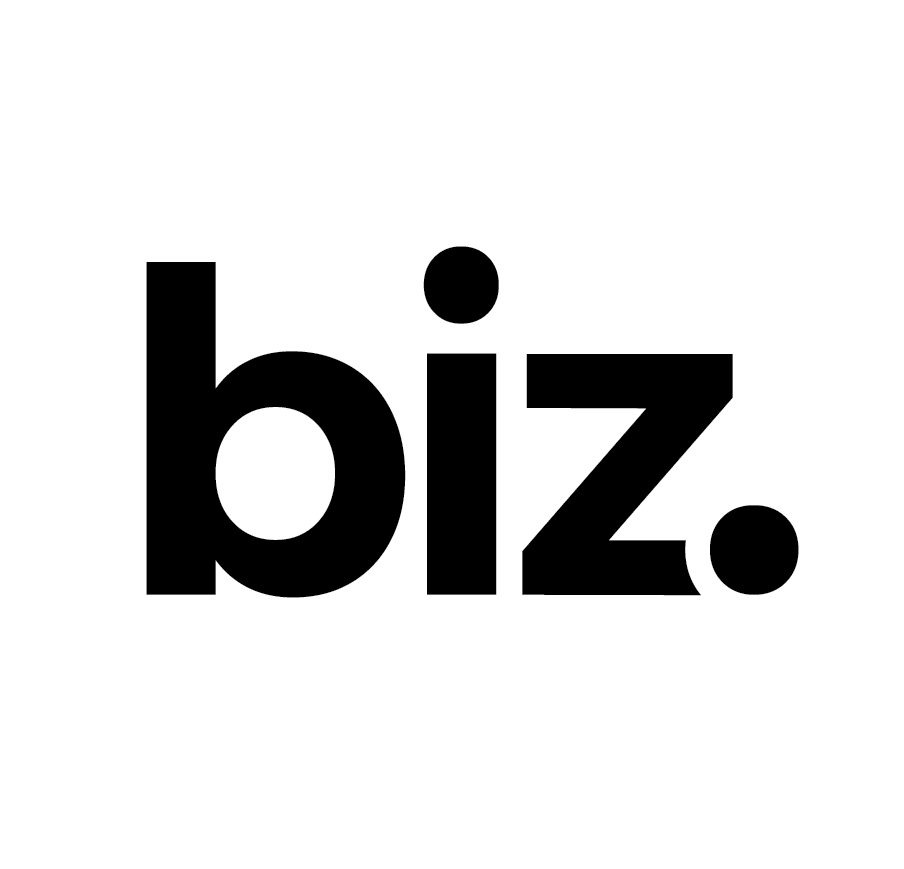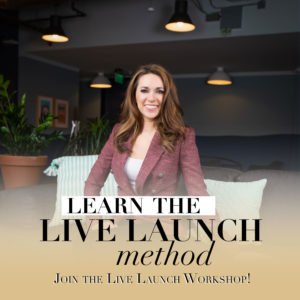Whether you’re an online service provider or a sales representative within an entrepreneurial company, mastering the art of high ticket closing is going to save you time, energy and maximize your profits.
However, many people are struggling to sell consistently into their high ticket flagship programs in the economic climate we are operating in today.
In this article, we’re going to break down the key components of closing high ticket clients in 2023:
- Why high ticket is still working in a recession, and what you need to know
- The difference between high and low ticket products, programs and services – and when to leverage both
- 4 pillars of successful high ticket sales
- Identifying objections
- Perfecting your pitch
- How to automate and streamline the customer journey
- The key components of an effective follow up and nurture process
- Common mistakes entrepreneurs make and how to avoid them
What is high ticket closing, and why is it important?
Recurring revenue is crucial to sustainable business success.
Having a scalable, high ticket offer is a way to generate recurring revenue and give you the gift of freedom AND stability.
It requires a much lower volume of customers to get to your revenue goals, allows you to create an exceptional and custom client experience, and protects your time and bandwidth to grow and scale the business.
Think about it: if you have a goal of generating $1 million in one year, and you have a $399 course, you would need more than 2,500 customers to reach your goal.
Not only that – but if you’re new to the entrepreneurial space, you may not even have an audience that size to sell to!
Now, if you had a $30,000 program, you’d only need 34 clients. Seems more feasable, right?
This short video explains why we recommend every service provider starts out with a scalable, high ticket offer:
High ticket sales vs. low ticket sales – and when to have both:
High ticket vs. low ticket sales isn’t a “right vs. wrong” conversation – it’s much more about timing and stage of business.
Many times business owners have it backwards – they start with a low ticket product, course, or program, and then want to launch a more expensive, high-ticket offer.
At The Business Advisory, we teach clients to focus on selling high ticket first – meaning private 1:1 offers at the highest possible price point – before moving down the spectrum into low ticket offers, instead of the other way around.
Why? Because the cost to acquire a customer is going to be the same whether you’re selling a cheap course or expensive program – so it will end up costing you more to sell into a low ticket course than it would to sell into a high ticket program.
The earlier you are in business, the higher ticket you want to sell.
Why? Because you’ll need less leads and clients to make a stable income, which will allow you to then reinvest in your business for growth.
As you build your audience and create more leverage, the compounding effect over time allows you to move up the income stream and start building out more passive, low ticket products.
In our world, “low ticket” is considered an offer under $10K.
A low ticket offer is an affordable way to offer high-value content that gives your buyer a tangible result and solves a pressing problem – for a much lower investment.
Typically, your high ticket and low ticket offer would complement one another, and your low ticket offer should be a springboard that flows into your higher tier programs.
A low ticket offer is also an opportunity to downsell leads who aren’t at the point yet to invest in your higher tier programs or services – selling low ticket is great way to build your “internal buyer’s list” of leads who have purchased from you, and can now get a result for a lower investment until they’re ready to sign up for your flagship program.
Many people who decide to enroll in a course or program will quickly upsell into your high ticket program once they’ve gotten results – so it’s critical to prioritize client results at all levels and maintain a long-term vision when selling low ticket, so that you can turn one-time buyers into clients for life and pivot them into your next offer once they’re ready.
If you’re considering launching a low-ticket offer, think about it this way: what’s one problem you can solve immediately that will get your buyer to the place to be able to invest in your high ticket program?
Your low ticket offer should be a lighter lift and more passive sale that doesn’t necessarily require a consultation call, but that you can direct people to a sales page to purchase from directly.
The higher your price point, the more reliant the sale becomes on a consultation.
Additionally, it should not require your direct involvement from a service delivery standpoint. Low ticket offers are typically self-paced content, although you can offer a live group component with you as an added bonus.
Making passive low ticket sales daily in your business comes from building your audience over time, creating engagement, and improving your content to conversion strategy. That doesn’t mean high ticket closing is harder than low ticket closing – it’s more about creating a custom, long-term, relationship-based approach
When you eventually transition from being the primary salesperson to building a sales team who can take consults and close without you, they can earn a percentage of the sale through a commission structure that poses no risk to the business owner – which is how high ticket closers make money.
This short video explains how you can create uncapped commission plans for your sales team, so that they can build wealth as an intrapreneur within your company:
Preparing for a longer buying cycle in 2023
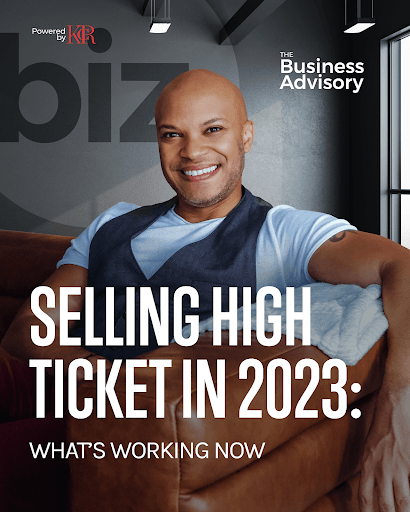
The consumer mentality in the service space world, especially high ticket services, has always operated this way: you discover a brand, you study and observe what they do, you build trust and rapport, you go through a know-like-trust-buy cycle, you decide when you’re ready to make the investment, and once the day comes – you pull the plug.
However, over the last five years, money was flowing more easily and from so many directions – that people were making massive investments without thinking twice.
It was easy to make money, it was easy to close clients, it was easy to attract leads,
Now, the market is reverting back to a more natural buying cycle, where people are doing their research and taking their time when making large investments.
It’s important to remember, though, that while the buying cycle is longer than it was in the past, selling a premium-priced product, program or service is still 100% possible when you understand the key pillars of high ticket closing.
Understanding the 4 pillars of High Ticket Closing
1. Know Your Target Audience
When selling high ticket services, you want to remember to speak to the highest common denominator – not the lowest.
Think of the market like a pyramid: most service providers who are struggling to sell are targeting the bottom layer of the pyramid, where there’s not only tons of competition – but even less disposable income.
While the top might be a much smaller percentage of people, there’s far less competition and more disposable income to spend during economic slowdowns.
Plus, high ticket clients typically make buying decisions based on value and return on investment, not price. They aren’t looking for the best deal, they’re looking for the most significant transformation.
Premium, affluent buyers use social media and consume content much differently than the rest of the population – so when you’re developing a content to conversion strategy for your high ticket, flagship program, you’ll want to keep this in mind.
They usually consume content passively.
Although they may not be engaging on your posts directly with likes or comments, they are still watching what you post, how you interact with the market, and keeping tabs on your brand while they make a decision about purchasing from you.
If you want to attract premium buyers, don’t create content that appeals to the masses because your content “isn’t performing.”
Your messaging should speak to your ideal client at the top tier of your market, and don’t be influenced by vanity metrics.
Finally, high ticket clients want to work with companies that walk the talk.
How is your company giving back and contributing to society beyond just business? How can you be a role model for prospects? Consider these questions when auditing your brand positioning.
2. Establish Rapport and Trust
Building relationships with prospects is essential to successful sales. Establishing rapport and trust helps foster stronger connections and build credibility and authority.
High ticket clients typically don’t take to mass marketing – consider having a highly customized outreach approach when selling to these clients.
Do your research and learn as much as you can about their business before sending a general copy-paste message (unless you don’t want them to respond).
High ticket buyers want to speak with people they perceive to be at or past their level; they do not want to speak to a salesperson.
What that means is that if you have a high ticket closer or social seller doing outreach for your high ticket program, it is critical that they have positioned themselves in an elevated and sophisticated manner.
That means optimized social media profiles (on LinkedIn, Facebook, Instagram – or anywhere they are building an audience and doing direct outreach), professional headshots, confidence on camera, and high level, high value content posted consistently to position themselves as a trusted authority.
3. Create a Compelling, World-Class Offer
You want to create and sell a compelling, no-brainer offer that’s positioned as the one and only, premium solution for your market.
Your pricing is a reflection of that.
Many service providers have mindset blocks around offering high ticket services; however, As Oprah Winfrey said, “When you undervalue what you do, the world will undervalue who you are.”
Creating a high ticket offer may require a shift and elevation in your messaging, brand and even programming – which means, it’s important to identify what the gaps are at the next level in the market that you are servicing, and crafting an offer that solves high level problems and provides white-glove service to clients.
Your flagship, high ticket offer shouldn’t – and can’t – be built in theory. You have to get started delivering it first, to be able to let it unfold and evolve into a world-class solution.
Every element of your program should come about and evolve through serving your customer – so don’t hit pause or delay taking action to work on programming. Ever.
Pay attention to what’s getting them the best results and what isn’t. What needs to be added, changed, started or stopped?
Listen, ask questions, make changes, and let your offer evolve over time in conjunction with serving your customers.
When you make decisions in a vacuum, you run the risk of taking clients down the complete wrong path, or creating an offer there’s simply no need or demand for in the market.
Your high ticket offer should start with a promise, and teach your clients all of the “must know” elements to get them to that end transformation.
We recommend a 12-month program when selling high ticket, with a minimum of 6 months. Why?
Your offer should provide true transformation and significant results – and you can’t help people completely change their lives in 90 days or less.
While they can get started, learn a new skill, or form a new habit – it’s impossible to come full circle in a 6-week program.
This also allows you to seal the bond with your customer so that each sale becomes a client for life: someone who ascends through your programs or offers and works with you for years to come.
When you’re considering pricing your program, it’s important to increase incrementally so that you can get to the point where you have more team and resources to deliver an exceptional program in alignment with the pricing.
The higher the price point, the more you want to think about personalization, accountability and accessibility. That means live teaching components, 1:1 check ins, and other human-centric elements that you don’t find in a traditional course or low ticket program.
High ticket buyers want customization – they don’t want to participate in a cookie-cutter program that offers no real direction based on their unique circumstances.
When constructing and promoting your high-ticket offer, answer the following questions:
- What results will they achieve by the 90-day mark?
- What is the roadmap for helping them achieve this?
- What superpowers do you possess that you can utilize to help them achieve their goals?
- What is unique about you, your process, skillset, experience or methodology that gives you the ability to help clients achieve superior results?
- What is the risk of not doing this work? What is the reward if they do?
- What are the most common objections or reasons why someone would not want to do this work? What can you do to lower risk, raise reward, help them push through fear, and build trust?
4. Ask the right questions
It’s critical that pre-consultation you are asking the right qualifying questions so that you are spending time on calls with the right prospects.
For example: in business coaching companies, that might look like asking about their annual revenue, the size of their team, or how many clients they serve.
Whereas, fitness coaches might ask about weight, activity level, and whether or not they have a proper nutrition plan in place.
The goal is that you are only booking consultation calls with qualified buyers.
Generally, you want to ask questions that address these 6 pillars of qualifying prospects:
- Pricing: Can t
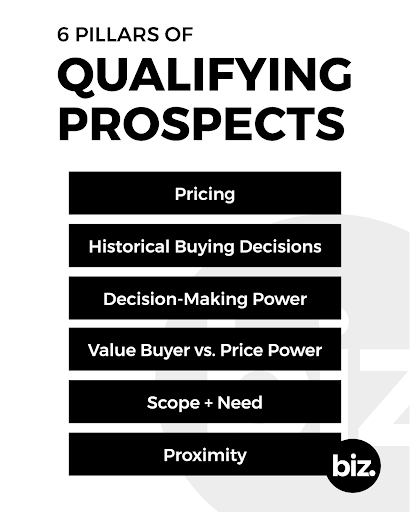 his person afford your product or service?
his person afford your product or service? - Historical Buying Decisions: Have they invested in a similar product or service in the past?
- Decision-Making Power: Does this person have the power to say “yes,” pull out the credit card + sign the dotted line?
- Value Buyer vs. Price Buyer: Is this person willing to pay based on impact and results, over price?
- Scope + Need: Does this person have a need for your offer, and can you meet their needs?
- Proximity: Can you get in front of your prospect?
Once it’s time to jump on a consultation with your potential new client, you’ll want to ask questions about their current situation versus desired situation – and why it’s important to them.
You want to uncover the emotional motivation behind why they want to move from their current situation to their desired situation, so you can diagnose the problem.
Address and overcome sales objections
Address potential concerns and give your prospect the information they need to make an informed buying decision.
By identifying objections and preparing responses, you can increase your chances of closing the deal and achieving success in high ticket sales.
Think of objections as merely a request for information.
When someone takes the time to share objections with you, what they really want is for you to meet them where they are and help them to overcome the hurdle standing in their way of the results they desire.
Objections simply mean the person needs to know more. There’s usually one thing they are stuck on; they want to say yes, they just need your help doing so.
Some of the top objections you’ll encounter in sales consultations are:
1. Time: many times, clients are concerned about their ability to use the program or service to its full potential because they don’t have time. You can overcome this objection by asking compelling questions around what their priorities really are. “You have 24 hrs in a day. Wouldn’t you agree that whatever is most important to you, you’ll make time for?”
If they agree, ask them how important it is to them to be able to get this specific result. Through this diagnoses, you will help them reframe their mindset about timing and decide whether or not this is important enough to make time for. Remember: you don’t want to convince someone; you simply want to uncover whether or not they’re willing to prioritize and make time for the program in order to yield the desired outcomes.
2. Money: perhaps they’re interested but unsure if they can swing the price tag. Again, you want to reframe this objection by getting them to see the value in spending money on your solution. You can ask something like:
“If this is the most important goal for you over the next few months, would you consider cutting other expenses or getting a loan to make it happen? Is the result you’re going to get worth the investment? If in X months you can achieve this result, is that worth the investment?”
Use stories, case studies, and testimonials that showcase other client success stories and remind them that they aren’t the first or only person to accomplish this – others have done it, and they can too.
3. Will it work for me? People are habitual buyers. When they invest, it typically means they’ve invested in other things before – some that maybe didn’t get them a result. If they’re skeptical about whether or not your program or service will work for them, it’s your job to help them understand why that last one didn’t work and what your solution will do or provide that’s different.
4. Decision-making power: you don’t want to chase people who aren’t the primary decision maker in their company.
For example: if you’re on a consultation call with a marketing director chatting about agency services, but the CEO is the ultimate decision-maker – that’s the person you want to be on a consultation with.
When you spend time selling to people who don’t have the power to say “yes,” you waste time.
Be ruthless in your qualifying process to ensure you’re talking to the right people who have the power and authority to make the decision.
5. They’re enrolled in another similar program or service: some prospects will hold off on buying because they’ve already committed to another service and want to wait until the engagement is finished.
When overcoming this objection, consider how soon they want this transformation and if they’re willing to wait to make it happen. Ask something like:
“Are you willing to wait another X months and put your results on hold, even though you know X program isn’t working for you?”
When overcoming objections, use the LAER model in your conversations: listen, acknowledge, explore, and respond.
Remember to personalize every pitch to meet the potential clients’ specific needs, and above all else: keep it simple.
A confused mind always says “no.” Rather than communicating all of the features of your program, stick to anywhere from 5 to 7 bullet points of benefits, clearly communicating why it matters to them personally.
Implement these 3 critical closing techniques to ensure you’re running highly effective consultation calls with prospects:
Perfect your pitch with practice and refinement
Once you’ve mastered the 4 pillars, it’s time to practice, refine, and perfect your strategy.
We teach our clients the “One Conversation Close” method, which is designed to accelerate the buying process for qualified prospects.
The ultimate goal is to get your prospects to buy without scheduling multiple follow-up calls, so that you can protect your CEO schedule and bandwidth.
On one hand, the only way sales can happen consistently is by getting consultations booked on your calendar consistently.
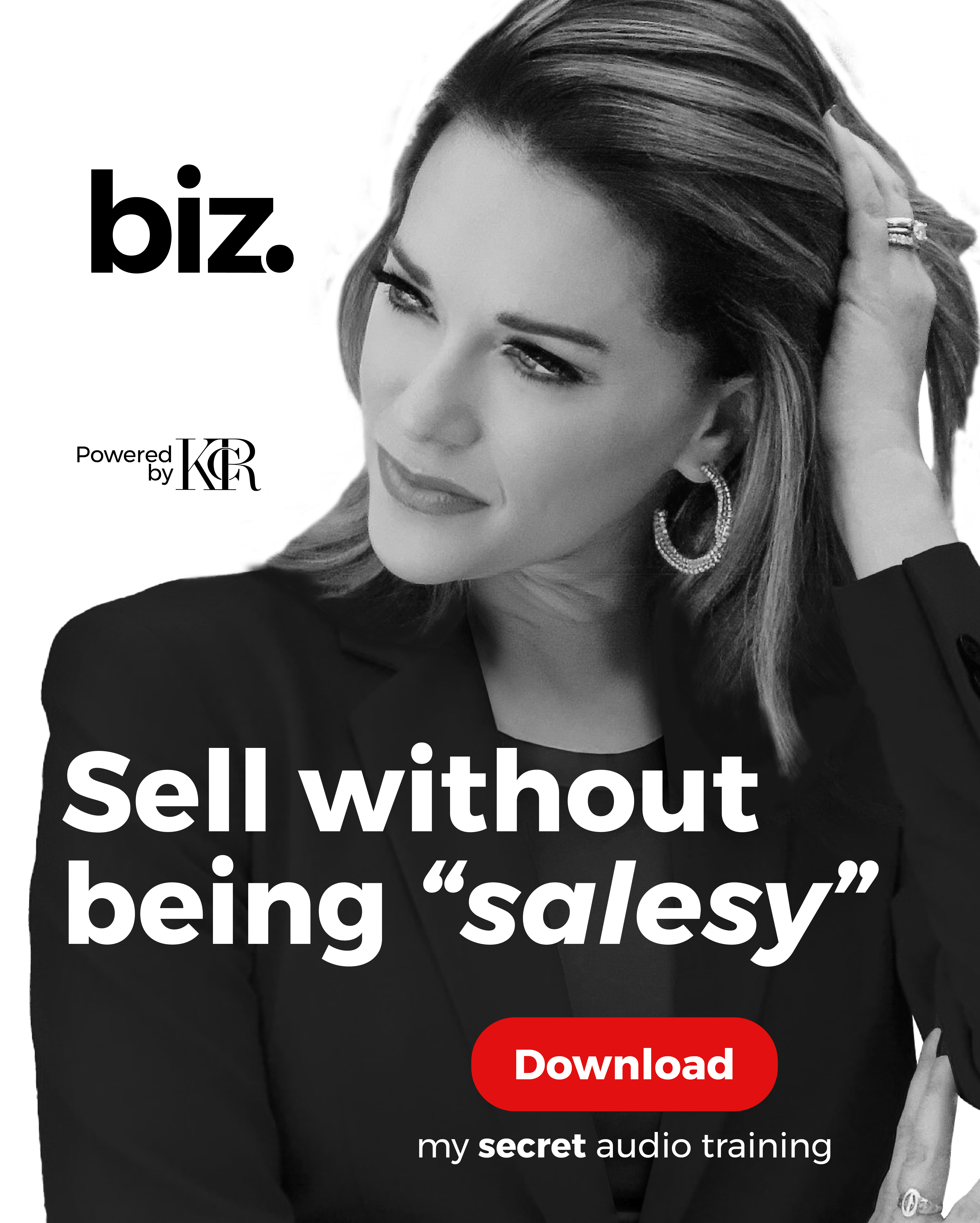
On the other hand, if you’re a solopreneur or still the primary salesperson in your business, these calls can take a substantial amount of time – leaving you with limited time for creating content, servicing c
lients, and all of the other demands that come with running an online business.
There’s no “perfect sales script” when it comes to selling high ticket: the truth is,
buyers are going to either buy your certainty, or they’re not going to buy based on your lack of certainty.
We call this concept “The Transfer of Conviction,” and if you want to learn how to leverage conviction in your sales conversations to close high ticket buyers on the spot, you can download my free secret audio training here.
Ultimately: it’s up to you to be so certain and confident in your solution, that you get them to believe in the possibilities and say yes to themselves.
At the end of the day, sales should be a win-win for both parties.
Leverage technology to streamline processes and communication
In a contracting market like this, the more sophisticated and optimized your segmentation process is, the better.
If you can create a customized path forward for your leads based on where they are and what their goals are, you will be able to get an even higher ROI of the time and money you spend generating leads for your high ticket program.
It’s much easier to segment leads when you have the right qualifying information.
Integrate qualifying questions into your opt-ins, event registrations, and other places where you typically capture lead information to help you better segment and customize that lead’s journey.
Using a tool such as Hubspot or GoHighLevel can help you streamline your follow up process with automated emails, text messages, and even tasks that notify you when a lead takes a specific action, so that you can stay on top of the nurture process.
“As companies recognise the potential within their data, the biggest shift in the approach to marketing and optimising their revenue is a change in their relationship to their audience. Instead of being on a permanent mission to reach new people and acquire new customers, many are now paying closer attention to the ones they have, and ways they can improve their experience with the brand. And a key tool behind nurturing your audience is email marketing, and your CRM.” –StrategIQ
Nurture leads with follow up messages
In a season of business like today’s, 85% of your time, energy and focus should be on your middle of funnel leads and reverting back to a true consultative sales cycle focused on relationship building versus conversion – especially considering high ticket clients will need a lengthy nurture process.
This means that while you focus on generating leads at the top of your funnel, the vast majority of your time should be spent building and nurturing the relationship with leads who have already been segmented within your ecosystem (either they are part of your internal buyers list, or have already been qualified) and moving them through multiple conversations – either with you or your closer
Remember, no mass marketing: consider how you can “break the static in your follow-up approach.
Rather than sending mass emails or templated messages, opt for custom, personalized voice messages, and maybe even sending a gift or handwritten note in the mail when trying to close a high ticket client.
Utilize high value resources like podcast episodes or books to continue nurturing the relationship and getting them further acquainted with your brand and your work.
Remember: intentionality is everything.
Every touchpoint you make with a lead should drive them to a consultation at some point. That doesn’t mean every communication should end with asking them to get on a call – it means you want them asking questions, engaging with the content and brand, and priming them to want to get on a call with you.
The most common mistakes business owners and social sellers make when it comes to high ticket closing
Avoid these simple mistakes in your sales process – here are some common challenges entrepreneurs and their sales teams face (and how to overcome them):
- Speaking more than you listen. The only way to effectively sell into a high ticket program is by fully understanding this person’s pain points, needs, and goals. You can’t speak to any of these things if you are not actively listening, and giving that person a chance to share. Think of each sales consultation as you diagnosing the problem – you need to understand the problem first.
- Not sharing consistently about your high ticket offer. Most people miss a critical step by having a high ticket offer – but not sharing about it online in their content or on their social media pages. They don’t create posts about their program or offer, it’s not clear in their profile or bio how someone can take the next step to work with them – and because of this, people simply won’t take the next step. Not making direct offers is the online equivalent of having a store with the lights and open sign turned off. If you want leads to inquire about your services, book a consultation, or apply to work with you – they need to know how and where to take the next step.
- Not consistently following up with leads. On average, it takes 8 touches to close a sale (RAIN sales training). We talked about a lengthier buying cycle in today’s economy: don’t let a lack of response take you out of the game. Be consistent in touching leads at least once a week in some way, shape or form.
- Not getting your clients a quick win in the first 30 days in your program. Once you’ve actually closed the sale, it doesn’t stop there. It’s just as important to continue to sell them on their belief – both in your program and in themselves. WOWing your clients within the first 30 days of working with you is critical, because in today’s economy, people are re-evaluating their buying decisions constantly. Airtight onboarding combined with a relentless focus on getting them an instant result in the first 30 days should kill those fears and concerns and keep your retention rates high.
Track results and optimize performance
By tracking your performance, you can identify areas of improvement and optimize your sales process accordingly. This allows you to continually refine your approach, improve your skills, and increase your chances of successfully closing deals.
If you’re wondering what key sales metrics to track, a general rule of thumb is to have no more than 3 to 5 key metrics in place. When it comes to high ticket closing, here are some key sales numbers you should know:
- Number of leads in your ecosystem. This could be a combination of leads generated organically, through paid advertising, speaking engagements and PR, and more.
- Number of qualified leads in your ecosystem. This determines how many leads you need to bring in in order to reach your goals. If you know that out of every 1000 leads generated, 200 of them are qualified, you can accurately predict how many leads you need to generate in order to hit your sales goals.
- Number of touchpoints required to book a consultation. What is the frequency of communication required to get a qualified lead on a call? Your touchpoints can be anything from connect calls, to follow up emails, to sending high value resources and content that keeps the conversation going and moves them through the sales funnel. Understanding this number will help you better understand the buying cycle and what’s required from a nurture standpoint.
- Number of consultations booked. This is the most important metric to measure, because consultations lead to closes. High ticket closers should aim for a 50% close rate, meaning of every 2 people who book a consultation, one of them will close.
- Number of closes. If you have a solid 50% close rate, you know that with a goal of 10 sales a month you will need 20 consultations booked. Tracking your closes will help you accurately determine how many consults need to be booked to reach your targets.
Conclusion
All this to be said, high ticket closing still works. It’s up to you to craft an offer that appeals to the top tier of your market, position it accordingly, and know how to run an effective consultation.
Consistency is key, especially in an economic climate like the one we’re in today. Have a solid nurture process in place to continue building the relationship and accelerating the know like and trust cycle, and you’ll be well on your way to closing consistent high ticket sales in your service-based business.
If you struggle with high ticket selling – whether it’s crafting the perfect offer from packaging to pricing, marketing and positioning your offer to attract qualified leads, or consistent sale each month – we work with clients on this inside our Empire Builders program. Have questions about whether or not the program is right for you? Book a discovery call with our team here.


